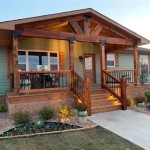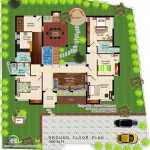Open Floor Plans for Small Homes: Maximizing Space and Light
Open floor plans, characterized by the absence of interior walls separating primary living areas such as the living room, dining room, and kitchen, have become increasingly popular in modern home design. This architectural approach is particularly beneficial for small homes, offering the potential to create a more spacious and airy environment than traditional layouts with compartmentalized rooms. Implementing an open floor plan in a small home requires careful planning and consideration of design elements to ensure functionality, flow, and visual appeal.
The advantages of open floor plans in small homes extend beyond simply making the space feel larger. They also promote better natural light distribution, improved social interaction, and increased versatility in furniture arrangement and usage. However, the successful execution of an open floor plan in a limited space hinges on strategic design choices that address potential drawbacks, such as noise control, lack of privacy, and the challenge of defining distinct zones within the open area.
Maximizing Space and Light
The primary advantage of an open floor plan in a small home is its ability to maximize the perception of space. By removing walls, the eye is allowed to travel further, creating a sense of openness and flow that would be impossible to achieve with traditional room divisions. This is particularly impactful in homes with limited square footage, where every inch of space counts.
Furthermore, open floor plans significantly improve the distribution of natural light. With fewer walls obstructing the flow of sunlight, natural light can penetrate deeper into the home, illuminating even the most interior areas. This not only makes the space brighter and more inviting but also reduces the need for artificial lighting, contributing to energy savings. Strategic window placement becomes even more crucial in open floor plans to maximize light intake and minimize glare.
To further enhance the feeling of spaciousness, light color palettes should be employed on walls, ceilings, and flooring. Light colors reflect light, making the space appear larger and brighter. Mirrors can also be strategically placed to reflect light and create the illusion of depth. Minimizing clutter is also essential for maintaining a sense of openness. Storage solutions such as built-in shelves and multi-functional furniture can help keep the space organized and free from visual obstructions.
The selection of furniture should also be carefully considered. Smaller-scale furniture pieces are generally preferable in small open floor plans as they take up less visual and physical space. Floating furniture, such as sofas and chairs with exposed legs, can further enhance the feeling of airiness. Avoiding bulky or ornate furniture is crucial for maintaining a sense of openness and preventing the space from feeling cramped.
Defining Zones Within an Open Space
While the open nature of the floor plan is a key benefit, it's equally important to define distinct zones for different activities within the shared space. This helps to create a sense of order and functionality, preventing the open area from feeling like one large, undefined room. There are various methods for defining zones without resorting to solid walls, preserving the openness of the design.
Furniture arrangement is a powerful tool for delineating zones. For example, a sofa can be used to define the boundary between the living room and dining area, while a kitchen island can serve as a visual separation between the kitchen and living space. The strategic placement of rugs can also help to define distinct zones. For instance, a large area rug can be used to anchor the living room seating area, while a smaller rug can define the dining area.
Changes in flooring materials or levels can also effectively define zones. For example, using hardwood flooring in the living and dining areas and tile in the kitchen can visually separate these spaces. A slight step up or down between zones can also create a subtle but effective division. However, level changes should be carefully considered to avoid tripping hazards, particularly in smaller homes with limited space.
Architectural elements such as partial walls, columns, or decorative screens can also be used to create visual separation without completely closing off the space. These elements provide a sense of enclosure while still allowing light and airflow to pass through. Bookshelves can also serve as effective room dividers, providing storage while simultaneously defining zones. Plants can also be used to create natural screens, adding visual interest and a touch of greenery to the space.
Lighting can also play a role in defining zones. Different types of lighting can be used to create distinct atmospheres in different areas of the open space. For example, recessed lighting can be used in the kitchen, while ambient lighting can be used in the living room. Task lighting can be used in specific areas, such as a reading nook or a home office, to provide focused illumination.
Addressing Potential Challenges
While open floor plans offer numerous advantages, they also present certain challenges that must be addressed to ensure a comfortable and functional living environment. Noise control is a primary concern in open floor plans, as sound can easily travel throughout the entire space. Lack of privacy can also be an issue, particularly when multiple people are occupying the same open area. Maintaining a cohesive aesthetic throughout the open space is also crucial to prevent it from feeling disjointed.
To mitigate noise issues, consider incorporating sound-absorbing materials into the design. Soft furnishings such as rugs, curtains, and upholstered furniture can help to dampen sound. Acoustic panels can also be installed on walls or ceilings to further reduce noise levels. In the kitchen, choosing quiet appliances can help to minimize noise pollution. Strategically placed bookshelves and other storage units can also help to absorb sound.
Addressing privacy concerns in an open floor plan requires creative solutions. Partial walls, screens, or curtains can be used to create temporary or semi-permanent divisions when privacy is needed. Multi-functional furniture, such as folding screens or room dividers, can also be used to create flexible privacy solutions. Utilizing different levels can also create a sense of separation and privacy. Designated quiet zones, such as a reading nook or a small office area, can also provide a private space within the open area.
Maintaining a cohesive aesthetic throughout the open space is essential for creating a harmonious and visually appealing environment. Choose a consistent color palette and style for all of the furnishings and finishes in the open area. Use similar materials and textures to create a sense of unity. Pay attention to the flow of lines and shapes throughout the space to ensure that everything feels connected. Avoiding clashing styles and colors is crucial for maintaining a cohesive look.
In summary, open floor plans can be a highly effective design strategy for small homes, creating the illusion of greater space, improving natural light distribution, and fostering a more social and interactive living environment. Careful planning and consideration of design elements, including furniture arrangement, zone definition, noise control, and privacy solutions, are essential for maximizing the benefits of an open floor plan in a limited space.

10 Small House Plans With Open Floor Blog Homeplans Com

10 Small House Plans With Open Floor Blog Homeplans Com

Open Concept Two Bedroom Small House Plan Other Examples At This Link Tiny Floor Plans Sims

Small Cottage House Plans With Modern Open Layouts Houseplans Blog Com

16 Best Open Floor House Plans With Photos The Designers

10 Small House Plans With Open Floor Blog Homeplans Com

Open Floor Plans And House Value Trend Ysis

10 Small House Plans With Open Floor Blog Homeplans Com

Open Concept Modern Cabin Floor Plans Houseplans Blog Com

1 Bedroom Apartment House Plans








